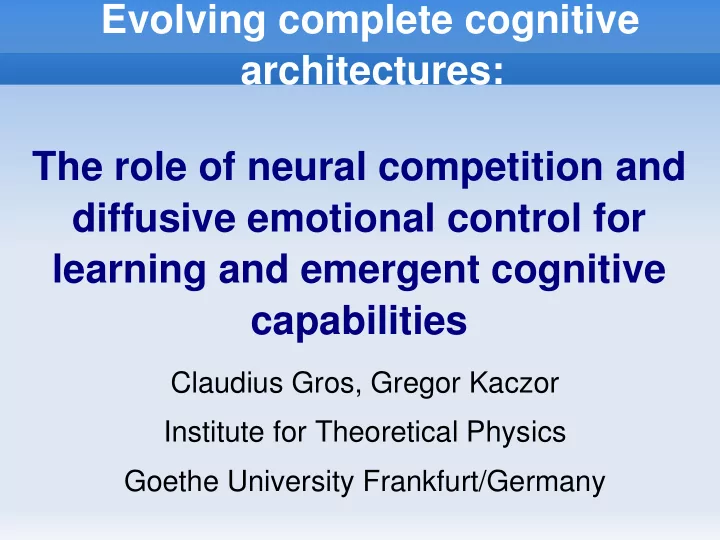

Evolving complete cognitive architectures: The role of neural competition and diffusive emotional control for learning and emergent cognitive capabilities Claudius Gros, Gregor Kaczor Institute for Theoretical Physics Goethe University Frankfurt/Germany
Assumption A complete cognitive agent is not just a complex input-output device, driven by the sensory input, but characterized by autonomously generated internal activities. If so, how and when do these internal states and activity patterns build up the correlation with information it receives via the sensory data input stream?
Assumption We think, that correlations between internal and external states are generated whenever the later are able to influence and modify the internal thought processes.
Cognitive System with autonomous dynamics Dhan Layer Backlinks Input Layer
Dense Homogeneous Associative Network Model Dhan Layer Backlinks Input Layer
Autonomous dynamics layer Excitatory links Inhibitory background - Dashed lines - reservoir - Continuous lines- activities
Autonomous internal activity and clique encoding - Dashed lines - reservoir - Continuous lines- activities
Fully connected layers Dhan Layer Backlinks Input Layer
Dense Homogeneous Associative Network Model Dhan Layer Backlinks Input Layer Regular Stimuli 90% Noise Stimuli 10%
Dense Homogeneous Associative Network Model Dhan Layer Backlinks Input Layer Regular Stimuli 90% Noise Stimuli 10%
Lerning between Layers Dhan Layer Backlinks Input Layer
Receptive Field Receptive Field Dhan Layer Backlinks Input Layer Regular Stimuli 90% Noise Stimuli 10%
Receptive Field
Model x = 1 − x i r i r i x i − r i r i ˙ bare pre j x j − z tanh r i post ∑ [ w ij w ij ] f w r i = f w bare r i N bare = ∑ z ij f z j g z x j r i j = 1 i = positive 1 − x ina − x i − negative i x i − x act ˙
References Gros, C., and Kaczor, G. 2008. Learning in cognitive systems with autonomous dynamics. Arxiv preprint arXiv:0804.1306 Gros, C. 2005. Self-sustained thought processes in a dense associative network. In Lecture notes in computer science, volume 3698, 366-379. Springer Gros, C. 2007. Neural Networks with transient state dynamics. New Journal of Physics 9:109 Gros, C. 2008. Complex and Adaptive Dynamical Systems. Springer. Gros, C. 2009. Emotions, diffusive emotional control and the motivational problem for autonomous cognitive systems. In Handbook of Research on Synthetic Emotions and Sociable Robotics: New Applications in Affective Computing and Artificial Intelligence. J. Vallverdu, D. Casacuberta (Eds.), IGI-Global. (in press)
Recommend
More recommend